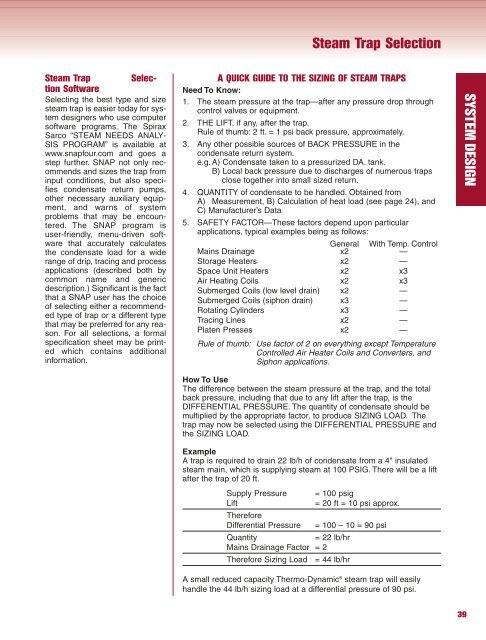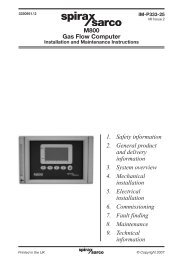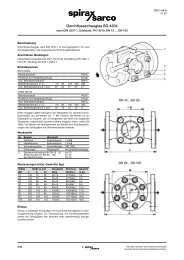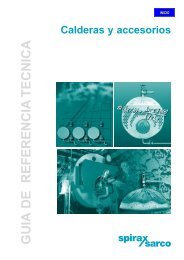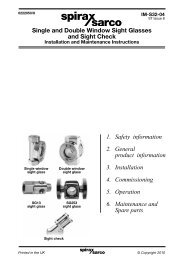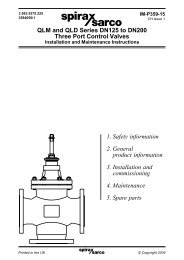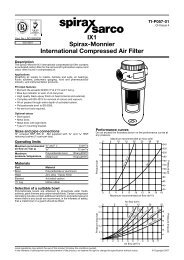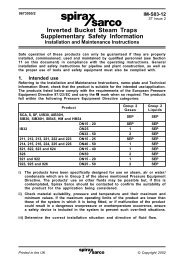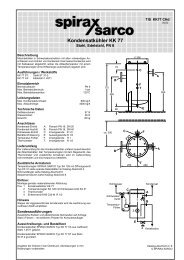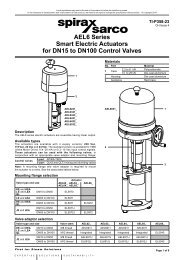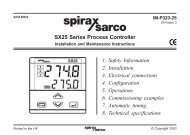2000 Hook-up Book - Spirax Sarco
2000 Hook-up Book - Spirax Sarco
2000 Hook-up Book - Spirax Sarco
Create successful ePaper yourself
Turn your PDF publications into a flip-book with our unique Google optimized e-Paper software.
Steam Trap Selection<br />
Software<br />
Selecting the best type and size<br />
steam trap is easier today for system<br />
designers who use computer<br />
software programs. The <strong>Spirax</strong><br />
<strong>Sarco</strong> “STEAM NEEDS ANALY-<br />
SIS PROGRAM” is available at<br />
www.snapfour.com and goes a<br />
step further. SNAP not only recommends<br />
and sizes the trap from<br />
input conditions, but also specifies<br />
condensate return pumps,<br />
other necessary auxiliary equipment,<br />
and warns of system<br />
problems that may be encountered.<br />
The SNAP program is<br />
user-friendly, menu-driven software<br />
that accurately calculates<br />
the condensate load for a wide<br />
range of drip, tracing and process<br />
applications (described both by<br />
common name and generic<br />
description.) Significant is the fact<br />
that a SNAP user has the choice<br />
of selecting either a recommended<br />
type of trap or a different type<br />
that may be preferred for any reason.<br />
For all selections, a formal<br />
specification sheet may be printed<br />
which contains additional<br />
information.<br />
Steam Trap Selection<br />
A QUICK GUIDE TO THE SIZING OF STEAM TRAPS<br />
Need To Know:<br />
1. The steam pressure at the trap—after any pressure drop through<br />
control valves or equipment.<br />
2. THE LIFT, if any, after the trap.<br />
Rule of thumb: 2 ft. = 1 psi back pressure, approximately.<br />
3. Any other possible sources of BACK PRESSURE in the<br />
condensate return system.<br />
e.g. A) Condensate taken to a pressurized DA. tank.<br />
B) Local back pressure due to discharges of numerous traps<br />
close together into small sized return.<br />
4. QUANTITY of condensate to be handled. Obtained from<br />
A) Measurement, B) Calculation of heat load (see page 24), and<br />
5.<br />
C) Manufacturer’s Data<br />
SAFETY FACTOR—These factors depend <strong>up</strong>on particular<br />
applications, typical examples being as follows:<br />
Mains Drainage<br />
General<br />
x2<br />
With Temp. Control<br />
—<br />
Storage Heaters x2 —<br />
Space Unit Heaters x2 x3<br />
Air Heating Coils x2 x3<br />
Submerged Coils (low level drain) x2 —<br />
Submerged Coils (siphon drain) x3 —<br />
Rotating Cylinders x3 —<br />
Tracing Lines x2 —<br />
Platen Presses x2 —<br />
Rule of thumb: Use factor of 2 on everything except Temperature<br />
Controlled Air Heater Coils and Converters, and<br />
Siphon applications.<br />
How To Use<br />
The difference between the steam pressure at the trap, and the total<br />
back pressure, including that due to any lift after the trap, is the<br />
DIFFERENTIAL PRESSURE. The quantity of condensate should be<br />
multiplied by the appropriate factor, to produce SIZING LOAD. The<br />
trap may now be selected using the DIFFERENTIAL PRESSURE and<br />
the SIZING LOAD.<br />
Example<br />
A trap is required to drain 22 lb/h of condensate from a 4" insulated<br />
steam main, which is s<strong>up</strong>plying steam at 100 PSIG. There will be a lift<br />
after the trap of 20 ft.<br />
S<strong>up</strong>ply Pressure = 100 psig<br />
Lift<br />
Therefore<br />
= 20 ft = 10 psi approx.<br />
Differential Pressure = 100 – 10 = 90 psi<br />
Quantity = 22 lb/hr<br />
Mains Drainage Factor = 2<br />
Therefore Sizing Load = 44 lb/hr<br />
A small reduced capacity Thermo-Dynamic ® steam trap will easily<br />
handle the 44 lb/h sizing load at a differential pressure of 90 psi.<br />
39<br />
SYSTEM DESIGN


